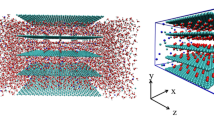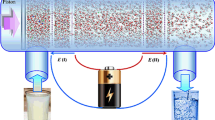Abstract
Multilayer graphene membranes could be considered as an efficient membrane in water desalination processes based on the reverse osmosis (RO) method. In this study, we designed multilayer graphene channels using the molecular dynamics (MD) simulation approach. The effects of different parameters, such as channel width and length, and the pressure on the operation of the designed channels were examined, in the absence and presence of electric fields with various amplitudes and directions. The results indicated that the ion separation and water flow through the channels were modified under the application of the electric fields. Additionally, it has been shown that salt rejection and water flow could be controlled by the channel’s structural parameters mentioned above. The obtained results of this study at the molecular level can improve the knowledge of designing membranes for water purification processes.

Using MD method a multilayer graphene membrane was designed to separate Na+ and Cl– ions from a NaCl solution by the aid of external electric field, which can significantly effect the membrane operation.








Similar content being viewed by others
References
Konatham D, Yu J, Ho TA, Striolo A (2013) Simulation insights for graphene-based water desalination membranes. Langmuir 29:11884–11897
Cohen-Tanugi D, McGovern RK, Dave SH, Lienhard JH, Grossman JC (2014) Quantifying the potential of ultra-permeable membranes for water desalination. Energy Environ Sci 7:1134–1141
Rikhtehgaran S, Lohrasebi A (2015) Water desalination by a designed nanofilter of graphene-charged carbon nanotube: a molecular dynamics study. Desalination 365:176–181
Homaeigohar S, Elbahri M (2017) Graphene membranes for water desalination. NPG Asia Mater 9:e427. https://doi.org/10.1038/am.2017.135
Cohen-Tanugi D, Grossman JC (2012) Water desalination across nanoporous graphene. Nano Lett 12:3602–3608
Sun P, Wang K, Zhu H (2016) Recent developments in graphene-based membranes: structure, mass-transport mechanism and potential applications. Adv Mater 28:2287–2310
Abraham J, Vasu KS, Williams CD, Gopinadhan K, Su Y, Cherian CT, Dix J, Prestat E, Haigh SJ, Grigorieva IV (2017) Tunable sieving of ions using graphene oxide membranes. Nat Nanotechnol 12:546–550
Lohrasebi A, Rikhtehgaran S (2018) Ion separation and water purification by applying external electric field on porous graphene membrane. Nano Res 11(4):2229–2236
Wang EN, Karnik R (2012) Water desalination: graphene cleans up water. Nat Nanotechnol 7:552
O’Hern SC, Stewart CA, Boutilier MS, Idrobo JC, Bhaviripudi S, Das SK, Kong J, Laoui T, Atieh M, Karnik R (2012) Selective molecular transport through intrinsic defects in a single layer of CVD graphene. ACS Nano 6:10130–10138
Nicolaï A, Sumpter BG, Meunier V (2014) Tunable water desalination across graphene oxide framework membranes. Phys Chem Chem Phys 16:8646–8654
An D, Yang L, Wang TJ, Liu B (2016) Separation performance of graphene oxide membrane in aqueous solution. Ind Eng Chem Res 55:4803–4810
Cohen-Tanugi D, Lin LC, Grossman JC (2016) Multilayer nanoporous graphene membranes for water desalination. Nano Lett 16:1027–1033
Cohen-Tanugi D, Grossman JC (2015) Nanoporous graphene as a reverse osmosis membrane: recent insights from theory and simulation. Desalination 366:59–70
Kumar Kannam S, Todd B, Hansen JS, Daivis PJ (2012) Slip length of water on graphene: limitations of non-equilibrium molecular dynamics simulations. J Chem Phys 136:024705
Dahanayaka M, Liu B, Hu Z, Pei QX, Chen Z, Law AWK, Zhou K (2017) Graphene membranes with nanoslits for seawater desalination via forward osmosis. Phys Chem Chem Phys 19:30551–30561
Wu S, Yang R, Shi D, Zhang G (2012) Identification of structural defects in graphitic materials by gas-phase anisotropic etching. Nanoscale 4:2005–2009
O’Hern SC, Jang D, Bose S, Idrobo JC, Song Y, Laoui T, Kong J, Karnik R (2015) Nanofiltration across defect-sealed nanoporous monolayer graphene. Nano Lett 15:3254–3260
Perreault F, De Faria AF, Elimelech M (2015) Environmental applications of graphene-based nanomaterials. Chem Soc Rev 44:5861–5896
Wang J, Zhang P, Liang B, Liu Y, Xu T, Wang L, Cao B, Pan K (2016) Graphene oxide as an effective barrier on a porous nanofibrous membrane for water treatment. ACS Appl Mater Interfaces 8:6211–6218
Cheng C, Jiang G, Garvey CJ, Wang Y, Simon GP, Liu JZ, Li D (2016) Ion transport in complex layered graphene-based membranes with tuneable interlayer spacing. Sci Adv 2:e1501272
Hong S, Constans C, Surmani Martins MV, Seow YC, Guevara Carrió JA, Garaj S (2017) Scalable graphene-based membranes for ionic sieving with ultrahigh charge selectivity. Nano Lett 17:728–732
Chen L, Shi G, Shen J, Peng B, Zhang B, Wang Y, Bian F, Wang J, Li D, Qian Z (2017) Ion sieving in graphene oxide membranes via cationic control of interlayer spacing. Nature 550:380
Bateni A, Susnar S, Amirfazli A, Neumann A (2004) Development of a new methodology to study drop shape and surface tension in electric fields. Langmuir 20:7589–7597
Sint K, Wang B, Král P (2008) Selective ion passage through functionalized graphene nanopores. J Am Chem Soc 130:16448–16449
Liu J, Wang M, Chen S, Robbins MO (2012) Uncovering molecular mechanisms of electrowetting and saturation with simulations. Phys Rev Lett 108:216101
Song F, Li B, Liu C (2013) Molecular dynamics simulation of nanosized water droplet spreading in an electric field. Langmuir 29:4266–4274
Corson LT, Tsakonas C, Duffy BR, Mottram NJ, Sage IC, Brown CV, Wilson SK (2014) Deformation of a nearly hemispherical conducting drop due to an electric field: theory and experiment. Phys Fluids 26:122106
Zhu J, Lan Y, Du H, Zhang Y, Su J (2016) Tuning water transport through nanochannels by changing the direction of an external electric field. Phys Chem Chem Phys 18:17991–17996
Kargar M, Lohrasebi A (2017) Deformation of water nano-droplets on graphene under the influence of constant and alternative electric fields. Phys Chem Chem Phys 19:26833–26838
Plimpton S (1995) Fast parallel algorithms for short-range molecular dynamics. J Comput Phys 117:1–19
Allen M, Tildesley DJ (1987) Computer simulation of liquids. Oxford University Press, New York
Conway BE (1981) Ionic hydration in chemistry and biophysics. Elsevier, New York
Author information
Authors and Affiliations
Corresponding author
Electronic supplementary material
ESM 1
(AVI 29166 kb)
Rights and permissions
About this article
Cite this article
Kargar, M., Khashei Varnamkhasti, F. & Lohrasebi, A. Influence of electric fields on the efficiency of multilayer graphene membrane. J Mol Model 24, 241 (2018). https://doi.org/10.1007/s00894-018-3774-9
Received:
Accepted:
Published:
DOI: https://doi.org/10.1007/s00894-018-3774-9




